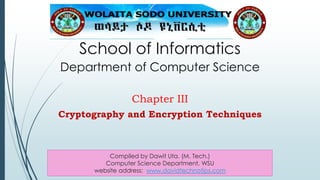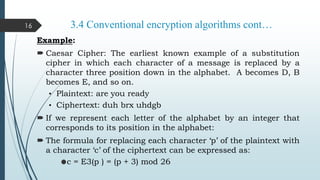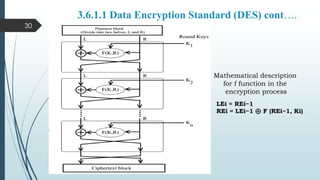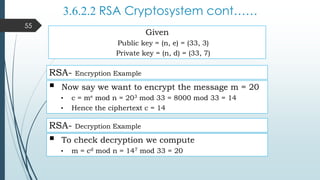This document provides an overview of cryptography and encryption techniques. It discusses the basic cryptographic terms and historical background of cryptography. It then describes different cipher techniques including transposition cipher and substitution cipher. It also discusses conventional encryption algorithms such as DES, AES, and RSA. Symmetric key cryptography and public key cryptography are explained. The document also covers digital signatures, cryptanalysis, and cryptographic systems in general.
































![Decryption of DES cont….
We can write the following equations for the output of the first decryption
round
LD1 = RD0
= LE16
= RE15
RD1 = LD0 ⊕ F (RD0, K16)
= RE16 ⊕ F (LE16, K16)
= [LE15 ⊕ F (RE15, K16)] ⊕ F (RE15, K16)
= LE15
33](https://image.slidesharecdn.com/computersecuritychapteriii-230527185138-e4709779/85/Computer-Security-Chapter-III-pdf-33-320.jpg)












![Symmetric and Public Key cont….
3.6.2 Public Key encryption/cryptography
Public key cryptography, commonly known asymmetric encryption, uses two
different keys, a public key known to all and a private key known only to the sender
and the receiver.
It has made cryptography available for the general public and made many of today’s
on-line application feasible
It uses Mathematical functions whose inverse is not known by Mathematicians of the
day. Both the sender and the receiver own a pair of keys, one public and the other a
closely guarded private one.
Keys for encryption and decryption are different but form a unique pair.
P = D [E (P) ]
Only one of the keys need to be private while the other can be public.
46](https://image.slidesharecdn.com/computersecuritychapteriii-230527185138-e4709779/85/Computer-Security-Chapter-III-pdf-46-320.jpg)



















